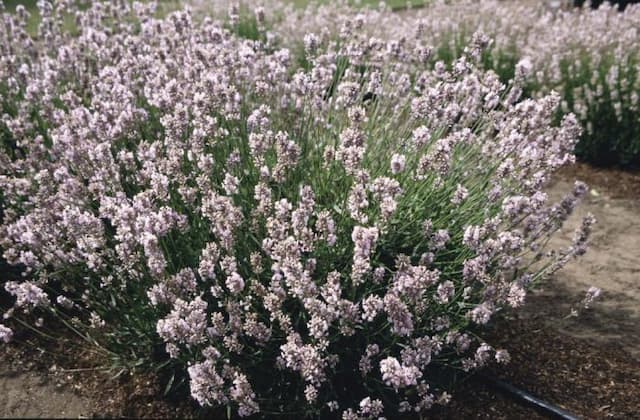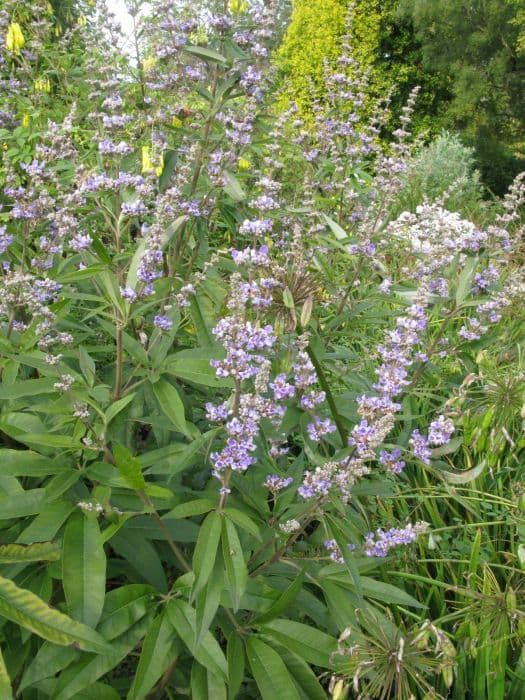Dwarf Basil Ocimum basilicum 'Pluto'

ABOUT
The plant known commonly as Pluto basil is a compact and bushy variety of basil. Its leaves are deep green, small, and have a uniform shape, with a lush and dense appearance that creates a textured effect. The leaves grow closely together, giving the plant a very full look. The edges of the leaves are slightly serrated, making them appear somewhat jagged when observed closely. The plant often produces small, delicate flowers that can add a pop of color and visual interest. These flowers are grouped in spike-like formations and are usually white or light lavender in color. The overall appearance of this plant is decorative and appealing, with a vibrant color palette that can brighten up any herb garden or container. Its aromatic leaves are frequently used both for culinary purposes and as an ornamental feature.
About this plant
 Names
NamesFamily
Lamiaceae.
Synonyms
Dwarf Basil, Pluto Basil, Miniature Basil, Bush Basil, Compact Basil.
Common names
Ocimum basilicum 'Pluto'.
 Toxicity
ToxicityTo humans
Basil, which includes the Ocimum basilicum 'Pluto' variety, is generally considered safe for human consumption. It is commonly used as a culinary herb, and there are no significant reports of toxicity in humans from ingesting basil. Eating basil in normal food amounts is unlikely to cause any adverse effects. However, as with any plant, individuals could potentially experience allergic reactions, but this is relatively rare. Ingesting extremely large quantities could potentially cause issues, but this would be an unusual and excessive intake of the herb.
To pets
Basil, generally speaking, is not toxic to pets. The Ocimum basilicum 'Pluto' variant is safe for animals like dogs and cats when consumed in small, culinary quantities. It is not known to cause any significant health issues. However, as with humans, individual animals may have allergies or sensitivities, and consuming large amounts of any herb can potentially cause gastrointestinal upset, such as vomiting or diarrhea, due to the unusual amount of roughage and essential oils in the herb. It's always recommended to introduce any new food into your pet's diet gradually and to consult with a veterinarian if you have concerns about how your pet might react to basil.
 Characteristics
CharacteristicsLife cycle
Annuals
Foliage type
Deciduous
Color of leaves
Green
Flower color
White
Height
1 feet (30 cm)
Spread
1 feet (30 cm)
Plant type
Herb
Hardiness zones
10
Native area
Asia
Benefits
 General Benefits
General Benefits- Culinary Usage: Ocimum basilicum 'Pluto', commonly known as Dwarf Basil, is often used in cooking to flavor dishes, including sauces, pestos, and salads.
- Aromatic: Dwarf Basil emits a pleasant fragrance, which makes it popular for use in potpourris and as a natural deodorizer.
- Ornamental Value: With its compact size and attractive foliage, this variety is ideal for container gardens, borders, and as a decorative plant indoors or outdoors.
- Pollinator Attraction: The flowers of Dwarf Basil can attract beneficial pollinators like bees and butterflies to the garden.
- Companion Planting: The plant is said to improve the growth and flavor of certain vegetables and can deter pests when used in companion planting strategies.
- Herbal Tea Ingredient: Leaves of the Dwarf Basil plant can be used fresh or dried to make herbal teas.
- Easy to Grow: The plant is considered easy to cultivate, which makes it suitable for both experienced and novice gardeners.
- Culinary Variety: Provides a unique, spicy flavor that can bring a new dimension to traditional basil dishes and recipes.
 Medical Properties
Medical Properties- Anti-inflammatory: The essential oils present in Ocimum basilicum, commonly known as basil, have shown anti-inflammatory properties.
- Antioxidant: Basil contains various compounds with antioxidant effects which can help in protecting the body from oxidative stress.
- Antibacterial: The plant has antibacterial properties, especially against certain strains of bacteria, due to its essential oils and other phytochemicals.
- Antispasmodic: Basil can help in relieving muscle spasms due to its antispasmodic properties.
- Adaptogenic: Basil may help the body adapt to stress and exert a normalizing effect upon bodily processes.
- Analgesic: It may offer pain relief to some extent, though not as a primary pain management option.
 Air-purifying Qualities
Air-purifying QualitiesThis plant is not specifically known for air purifying qualities.
 Other Uses
Other Uses- Natural Dye: Basil 'Pluto' leaves can be used to create a natural green dye for fabrics, paper, or homemade crafts.
- Aromatherapy: The aromatic oils in the leaves may be used in aromatherapy for creating a soothing and calming environment.
- Bath Additive: Fresh or dried leaves can be added to bath water for a fragrant and refreshing bathing experience.
- Insect Repellent: The strong scent of basil 'Pluto' can be used to repel insects by placing crushed leaves around outdoor living spaces or on window sills.
- Flavor Enhancer: Small amounts of the leaves can be incorporated into homemade potpourri blends to add a fresh, herbaceous note.
- Homemade Sachets: Dried basil leaves can be used to fill sachets, providing a subtle fragrance in drawers and closets.
- Companion Planting: Basil 'Pluto' can be planted alongside other garden vegetables to help repel harmful pests and enhance the overall health of the garden.
- Seed Crafts: The tiny seeds of basil can be used for making decorative items such as seed mosaics or in artwork for their interesting texture and appearance.
- Bookmark Scenting: Dried leaves can be tucked into books as natural bookmarks that gradually release their aroma over time.
- Candle Making: Dried basil leaves can be incorporated into homemade candles to add a subtle fragrance when the candle burns.
Interesting Facts
 Feng Shui
Feng ShuiBasil is not used in Feng Shui practice.
 Zodiac Sign Compitability
Zodiac Sign CompitabilityBasil is not used in astrology practice.
 Plant Symbolism
Plant Symbolism- Luck: Basil is commonly associated with good fortune and has been used in various cultures to attract luck or ward off evil spirits.
- Love: In Italian folklore, basil is considered a sign of love, and it was often used as a token of affection during courtship.
- Protection: Across different cultures, basil has been used in rituals and placed in homes to offer protection and to purify spaces.
- Health: Due to its medicinal properties, basil symbolizes good health and has been used in traditional medicine to treat various ailments.
- Wealth: The plant's lush growth is sometimes connected to prosperity and is thought to attract wealth when grown in abundance.
- Sacredness: In Hinduism, basil, also known as Tulsi, is considered sacred and is revered as an earthly manifestation of the goddess Tulsi/Vrinda.
 Water
WaterDwarf basil requires consistent moisture, so it's important to water when the top inch of soil feels dry to the touch. On average, this might mean watering every 3-5 days, depending on environmental conditions. Use lukewarm water, and apply it gently at the base of the plant to avoid wetting the foliage, which could promote disease. A general guideline is to provide about 1/4 to 1/2 gallon of water per plant each week, although this can vary based on temperature and humidity. Be sure to adjust the amount and frequency of watering during hotter, drier periods or cooler, wetter periods.
 Light
LightDwarf basil thrives in full sunlight, so it's best to place it in a location where it will receive at least 6-8 hours of direct sunlight per day. An east or south-facing windowsill is ideal when growing indoors. Outdoors, ensure it's planted in a spot that is not shaded by other plants or structures.
 Temperature
TemperatureDwarf basil prefers warm temperatures and will grow best when daytime temperatures are between 70-80°F. It can tolerate temperatures as low as 50°F at night but should not be exposed to frost, as it is sensitive to cold. Temperatures above 90°F may stress the plant, so provide some shade during the hottest part of the day if necessary.
 Pruning
PruningPruning dwarf basil promotes bushier growth and prevents legginess. Pinch off the tip of each stem regularly, removing the top set of leaves to encourage branching. The best time to prune is when the plant is 6-8 inches tall, and it can be done throughout the growing season as needed to maintain the desired shape and size.
 Cleaning
CleaningAs needed
 Soil
SoilDwarf basil 'Pluto' thrives best in a well-draining soil mix rich in organic matter with a pH between 6.0 and 7.5; a blend of equal parts potting soil, compost, and perlite is ideal.
 Repotting
RepottingDwarf basil 'Pluto' should be repotted annually to replenish nutrients, as it is typically grown as an annual and does not usually live long enough to require multiple repotting sessions.
 Humidity & Misting
Humidity & MistingDwarf basil 'Pluto' prefers moderate humidity levels, around 40-60%, to mimic its native tropical climate.
 Suitable locations
Suitable locationsIndoor
Place dwarf basil 'Pluto' near a sunny window and keep soil moist.
Outdoor
Plant dwarf basil 'Pluto' in warm, sunny spot after frost risk.
Hardiness zone
Dwarf basil 'Pluto' is suited to USDA zones 9-11.
 Life cycle
Life cycleSweet basil 'Pluto' begins its life cycle when seeds are sown in warm soil and germinate, typically within 5 to 10 days. The seedlings emerge and enter the vegetative stage, developing a sturdy stem and bright green, aromatic leaves. As the plant matures, it enters the pre-flowering stage, where it readies to bloom. The flowering stage sees the formation of small, white flowers in a spiked inflorescence, usually during mid-summer to early fall. After pollination, the plant produces seeds within the flower structures, completing its reproductive cycle if seeds are allowed to mature before being harvested. Finally, as temperatures cool or if the plant is an annual, it enters senescence and dies, although it may continue to live and produce leaves if managed to prevent seed formation and grown in a region with mild winters.
 Propogation
PropogationPropogation time
Spring-Summer
The most popular method of propagating Ocimum basilicum 'Pluto', commonly known as Pluto basil, is through seed. To do this, one would typically sow the seeds indoors 6 to 8 weeks before the last frost date, lightly covering the seeds with soil, as they need some light to germinate. The ideal temperature for germination is between 70 to 75 degrees Fahrenheit (21 to 24 degrees Celsius). After sowing, it usually takes 7 to 14 days for the seeds to germinate. Once the seedlings have developed a couple of sets of true leaves and the threat of frost has passed, they can be transplanted outdoors to a sunny, well-draining location. Care should be taken to space the plants about 8 to 12 inches (20 to 30 centimeters) apart to allow for proper air circulation and growth.









